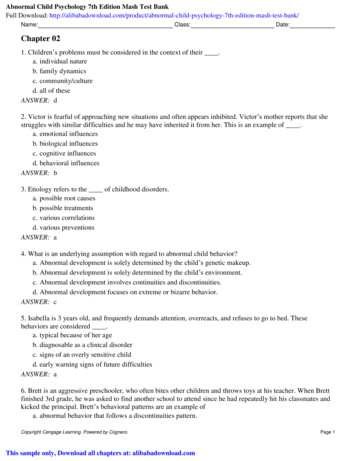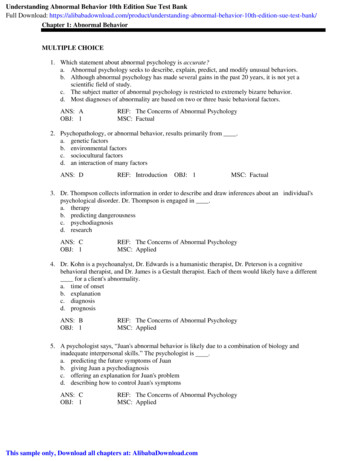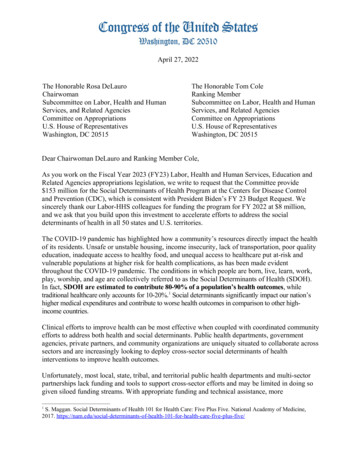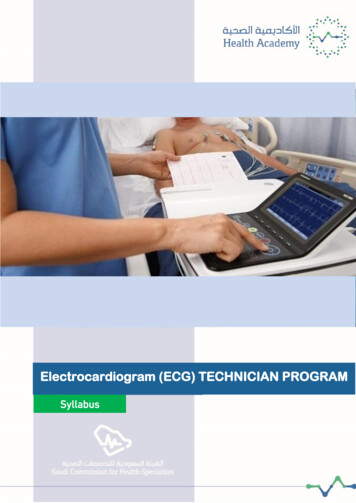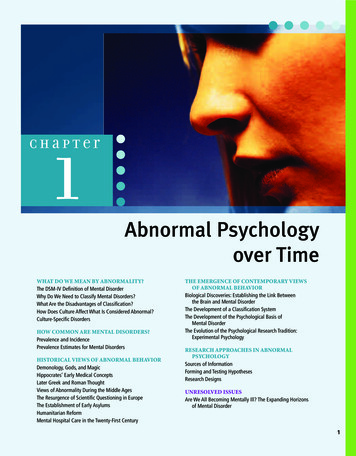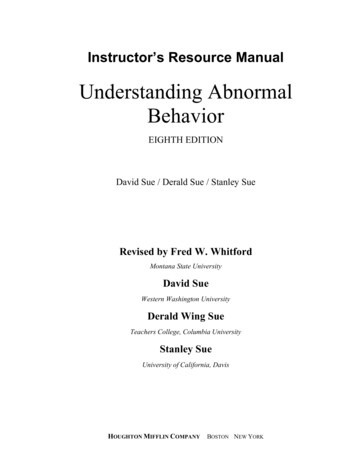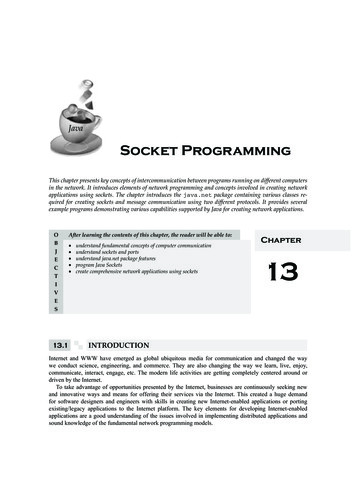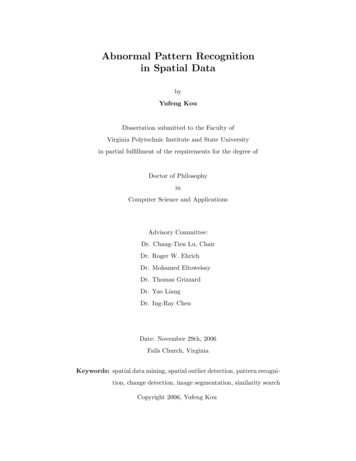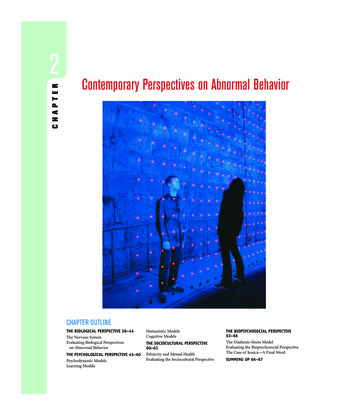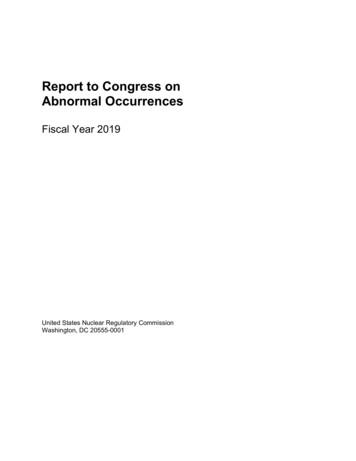
Transcription
Report to Congress onAbnormal OccurrencesFiscal Year 2019United States Nuclear Regulatory CommissionWashington, DC 20555-0001
ABSTRACTSection 208 of the Energy Reorganization Act of 1974, as amended (Public Law 93-438),defines an abnormal occurrence (AO) as an unscheduled incident or event that the U.S. NuclearRegulatory Commission (NRC) determines to be significant from the standpoint of public healthor safety. The Federal Reports Elimination and Sunset Act of 1995 (Public Law 104-66)changed the AO reporting frequency from quarterly to annually.This report describes nine events that occurred in Agreement State (AS) and no eventsinvolving NRC licensees that the agency identified as AOs during fiscal year (FY) 2019 basedon the criteria defined in Appendix A, “Abnormal Occurrence Criteria.” Seven AOs weremedical events as defined in Title 10 of the Code of Federal Regulations (10 CFR) Part 35,“Medical Use of Byproduct Material.” The eighth AO was a human exposure event and theninth AO involved a Category 2 source, as defined in 10 CFR Part 37, “Physical Protection ofCategory 1 and Category 2 Quantities of Radioactive Material.” The agency did not identify anyevents at commercial nuclear power plants as AOs.AS are those States that have entered into formal agreements with the NRC, in accordance withSection 274 of the Atomic Energy Act of 1954, as amended (AEA) (Public Law 83-703), toregulate certain quantities of AEA material at facilities within the States’ borders. Currently,there are 39 AS.Appendix A to this report presents the NRC’s criteria for identifying AOs. The NRC identifiedone event during FY 2019 that met the guidelines for inclusion in Appendix B, “Other Events ofInterest.” The event received significant media coverage due to extensive contamination ofpersonnel and building structure due to the breaching of a sealed cesium-137 source. Noevents meet the guidelines for inclusion in Appendix C, “Updates of Previously ReportedAbnormal Occurrences.” Appendix D, “Glossary,” defines terms used throughout this report.Appendix E, “Conversion Table,” presents conversions commonly used when calculating doses.iii
CONTENTSABSTRACT . iiiCONTENTS . vEXECUTIVE SUMMARY . viiINTRODUCTION . viiTHE LICENSING AND REGULATORY SYSTEM. viiREPORTABLE EVENTS .viiiAGREEMENT STATES .viiiINTERNATIONAL INFORMATION .viiiOTHER EVENTS OF INTEREST . ixUPDATES OF PREVIOUSLY REPORTED ABNORMAL OCCURRENCES . ixABBREVIATIONS . xiABNORMAL OCCURRENCES IN FISCAL YEAR 2019 . 1I.ALL LICENSEES . 1AS19-01Human Exposure Event at NRD-Advanced Static Control, GrandIsland, New York . 1AS19-02Stolen Industrial Radiography Cameras from WesternTechnologies, Inc., Phoenix, Arizona . 3II. COMMERCIAL NUCLEAR POWER PLANT LICENSEES . 4III. EVENTS AT FACILITIES OTHER THAN NUCLEAR POWER PLANTS AND ALLTRANSPORTATION EVENTS . 4AS19-03Medical Events at Swedish Medical Center, Englewood,Colorado . 4AS19-04Medical Event at Midwestern Regional Medical Center, Zion,Illinois . 6AS19-05Medical Event at Albert Einstein Healthcare, Philadelphia,Pennsylvania . 7v
AS19-06Medical Event at Holmes Regional Medical Center, Melbourne,Florida . 8AS19-07Medical Event at Physicians Surgical Center of Fort Worth, FortWorth, Texas . 9AS19-08Medical Event at Duke University Medical Center, Durham, NorthCarolina . 10AS19-09Medical Event at Vanderbilt University Medical Center, Nashville,Tennessee . 12APPENDIX A ABNORMAL OCCURRENCE CRITERIA . A-1APPENDIX B OTHER EVENTS OF INTEREST . B-1APPENDIX C UPDATES OF PREVIOUSLY REPORTED ABNORMAL OCCURRENCES. C-1APPENDIX D GLOSSARY . D-1APPENDIX E CONVERSION TABLE . E-1vi
EXECUTIVE SUMMARYINTRODUCTIONSection 208 of the Energy Reorganization Act of 1974, as amended (Public Law 93-438),defines an “abnormal occurrence” (AO) as an unscheduled incident or event that theU.S. Nuclear Regulatory Commission (NRC) determines to be significant from the standpoint ofpublic health or safety. The Federal Reports Elimination and Sunset Act of 1995 (Public Law104-66) modified the AO reporting frequency from quarterly to annually.This report describes events that the NRC or an Agreement State (AS) identified as AOs infiscal year (FY) 2019, based on the criteria defined in this report’s Appendix A, “AbnormalOccurrence Criteria,” that became effective in FY 2018. AS are those States that have enteredinto formal agreements with the NRC, in accordance with Section 274 of the Atomic Energy Actof 1954, as amended (AEA) (Public Law 83-703), to regulate certain quantities of AEA materialat facilities within the States’ borders. The NRC has determined that, of the incidents andevents reviewed for this reporting period, only those that are described in this report meet thecriteria for reporting as AOs. For each AO, this report documents the date and place, natureand probable consequences, cause or causes, and actions taken to prevent recurrence.Appendix A to this report presents the NRC’s criteria for identifying AOs. The NRC identifiedone event during FY 2019 that met the guidelines for inclusion in Appendix B, “Other Events ofInterest.” During this reporting period, no events met the guidelines for inclusion in Appendix C,“Updates of Previously Reported Abnormal Occurrences.” Appendix D, “Glossary,” definesterms used throughout this report. Appendix E, “Conversion Table,” presents conversionscommonly used when calculating doses.THE LICENSING AND REGULATORY SYSTEMThe system of licensing and regulation used by the NRC to carry out its responsibilities isimplemented through the rules and regulations in Title 10 of the Code of Federal Regulations.The NRC regularly conducts licensing reviews, inspections, enforcement, investigations,operating experience evaluations, incident response, and confirmatory research. The agencyinforms and involves stakeholders and the public to ensure openness and transparency in itsregulatory process.The NRC adheres to the philosophy that multiple levels of protection best ensure public healthand safety. The agency achieves and maintains these levels of protection through regulationsspecifying requirements that ensure the safe use of radioactive materials. Those regulationscontain design, operation, and quality assurance criteria appropriate for the various activitiesregulated by the NRC. Licensing, inspection, investigations, and enforcement programs offer aregulatory framework to ensure compliance with the regulations. In addition, the NRC is strivingto make the regulatory system more risk informed, and performance based, where appropriate.AS conduct regulatory programs that are adequate to protect public health and safety and arecompatible with the NRC’s program.vii
REPORTABLE EVENTSThe NRC initially issued the AO criteria in a Commission policy statement published inVolume 42 of the Federal Register (FR), page 10950 (42 FR 10950), on February 24, 1977,followed by several revisions. The agency published the most recent revision to the AO criteriain the FR on October 2, 2017 (82 FR 45907); the revised criteria became effective on that date.The NRC staff has used these criteria to define AOs for this FY 2019 report.Reviews of and responses to operating experience are essential to ensure that licenseesconduct their activities safely. To that end, NRC regulations require licensees to report certainincidents or events to the NRC. Such reporting helps to identify deficiencies and ensure thatcorrective actions are taken to prevent recurrence.The NRC and its licensees review and evaluate operating experience to identify safetyconcerns. The NRC responds to risk-significant issues through licensing reviews, inspections,enforcement, and enhancements to regulations. In addition, the agency maintains operationaldata in computer-based data files for more effective collection, storage, retrieval, and evaluationof events.The NRC routinely makes information and records on reportable events at licensed facilitiesavailable to the public. The agency also disseminates information through publicannouncements and special notifications to licensees and other stakeholders. The NRC issuesan FR notice describing AOs that occurred in the previous FY at facilities licensed or otherwiseregulated by the NRC or AS. In addition, the NRC routinely informs Congress of significantevents, including AOs that occur at licensed or regulated facilities.AGREEMENT STATESAS must maintain programs that are adequate to protect public health and safety and arecompatible with the NRC’s program for such materials. Currently, there are 39 AS. An ASreports event information in accordance with the compatibility criteria the NRC established in its“Agreement State Program Policy Statement” (82 FR 46840; October 6, 2017). The NRC alsohas procedures for evaluating materials events and identifying those that meet the AO criteria.The NRC uniformly applies the AO criteria (see Appendix A) to events at licensee facilities oractivities involving the use of radioactive material regulated by either the NRC or the AS. In1977, the Commission determined that the annual report to Congress should also includeevents that meet the criteria for AOs at licensees regulated by the AS. The Federal Registernotice that the NRC issues to disseminate AO-related information to the public includes theseevents as well.INTERNATIONAL INFORMATIONThe NRC exchanges information with various foreign governments that regulate nuclearfacilities and materials. The agency reviews and considers this international information in itsresearch and regulatory activities, as well as in its assessment of operating experience.Although the NRC may occasionally refer to such information in its AO reports to Congress, theagency reports only domestic AOs.viii
OTHER EVENTS OF INTERESTThe NRC offers information about events that do not meet the criteria for AOs but are of interestbased on the criteria in Appendix B to this report. The NRC identified one event that occurredduring FY 2019 that met these criteria.UPDATES OF PREVIOUSLY REPORTED ABNORMAL OCCURRENCESIn Appendix C, the NRC includes updates on previously reported AOs that remain open duringthe fiscal year addressed in the report or for which significant new information becomesavailable. Appendix C has no updates during this reporting period.ix
DEYAgencywide Documents Access and Management SystemAtomic Energy Act of 1954, as amendedabnormal occurrenceAgreement State(s)authorized userCode of Federal Regulationscentigray(s)curie(s)certified nuclear medicine technologistcomputerized tomographyU.S. Department of EnergyDepartment of HealthFederal Registerfiscal yeargigabecquerel(s)gray(s)high-efficiency particulate airiodineinformation noticemegabecquerel(s)millicurie(s)management directivemilliremmillisievert(s)U.S. Nuclear Regulatory Commissionpalladiumradiation absorbed doserubidiumroentgen equivalent manstrontiumsievert(s)terabecquerel(s)total effective dose equivalentyttriumxi
ABNORMAL OCCURRENCES IN FISCAL YEAR 2019Appendix A, “Abnormal Occurrence Criteria,” supplies the specific criteria for determiningwhether an event is an abnormal occurrence (AO). Appendix A contains criteria for three majorcategories:I.II.III.all licenseescommercial nuclear power plant licenseesevents at facilities other than nuclear power plants and all transportation eventsThis section of the report includes only the specific events in Categories I, II, and III for which anAO was reported. The identification number for all Agreement State(s) AO reports start with“AS.” Similarly, the identification number for all U.S. Nuclear Regulatory Commission (NRC) AOreports start with “NRC.”I.ALL LICENSEESDuring this reporting period, two events were identified as AOs based on Criterion I, “AllLicensees,” in Appendix A.AS19-01Human Exposure Event at NRD-Advanced Static Control, Grand Island,New YorkCriterion I.A.1(b) of Appendix A to this report provides, in part, that a human exposure eventshall be considered for reporting as an AO if any unintended radiation exposure to an adult (anyindividual 18 years of age or older) resulted in an annual sum of the deep dose equivalent(external dose) and committed dose equivalent (intake of radioactive material) to any individualorgan other than the lens of the eye, the bone marrow, and the gonads of 2,500 millisieverts(mSv) (250 rem) or more.Date and Place — April 1, 2019, Grand Island, NYNature and Probable Consequences—On April 1, 2019, NRD-Advanced Static Control reportedan internal radiation overexposure to one employee that resulted in an annual sum of the deepdose equivalent (external dose) and committed dose equivalent (intake of radioactive material)to any individual organ other than the lens of the eye, the bone marrow, and the gonads of2,500 mSv (250 roentgen equivalent man (rem)) or more. The employee attempted to clean upa small area of rusty contamination in a nonradioactive area of the licensee’s facilities. Theemployee inappropriately used a high-efficiency particulate air (HEPA) vacuum from the SilverRecovery area. This vacuum had previously been used to clean up americium-241 metal. Theemployee turned on the vacuum and noticed it was blowing out debris. The employeeimmediately turned off the vacuum and shut the doors because the area radiation alarms hadactivated, indicating that the vacuum debris being discharged was radioactive. After the doorswere shut, the radiation safety officer (RSO) was notified. The RSO sealed the location fromfurther entry. The RSO determined that the employee was in the contaminated area forapproximately 20 minutes. The RSO contacted the Department of Energy’s (DOE) Oak Ridge’sRadiation Emergency Assistance Center/Training Site and bioassay samples were collectedand sent out for processing. Bioassay results showed that the employee received 2,990 mSv1
(299 rem) to the maximally exposed organ (bone). The licensee is following the health of theemployee and does not expect any adverse health effects from this incident.Cause(s) — The primary root cause was determined to be the failure of a HEPA vacuum.Additional factors contributing to this event were improper use of a HEPA vacuum (use of thevacuum in an area for which it was not designed), inadequate procedures, and poor emergencytraining.Actions Taken To Prevent RecurrenceLicensee — The licensee revised its radiation protection procedures to prohibit the use ofpotentially contaminated equipment in areas where contamination is not expected and to clearlydefine the procedures to follow during an emergency. After the revisions to the procedureswere complete, the licensee staff received training on the revisions.State — The New York Department of Health, Bureau of Environmental Radiation Protection,conducted an onsite reactive inspection of the licensee. Based on the inspection, the Stateidentified several violations. The State will review the licensee’s corrective actions during thenext inspection.This event is closed for the purpose of this report.2
AS19-02Stolen Industrial Radiography Cameras from Western Technologies, Inc.,Phoenix, ArizonaCriterion I.C.1, “Theft, Diversion, or Loss of Licensed Material, or Sabotage or Security Breach”of Appendix A to this report provides, in part, that any stolen, diverted, abandoned, orunrecovered radioactive material that meets or exceeds the thresholds listed in Appendix A,“Category 1 and Category 2 Radioactive Materials,” to 10 CFR Part 37, “Physical protection ofcategory 1 and category 2 quantities of radioactive material,” shall be considered for reportingas an AO.Date and Place — April 28, 2019, Phoenix, AZNature and Probable Consequences — On April 28, 2019, Western Technologies, Inc. reportedthe theft and recovery of three industrial radiography cameras, each containing an activity thatexceeded the threshold for a Category 2 quantity of radioactive material. A licensee employee,who had been authorized for unescorted access to radioactive material, stole three industrialradiography cameras from the licensee’s secure storage area after normal working hourswithout approval from the licensee. Law enforcement was notified, and the cameras wererecovered and returned to secure storage on the day of the theft.Cause(s) — The disposition of the event is pending law enforcement investigation.Actions Taken to Prevent RecurrenceLicensee — The licensee upgraded their access security measures after normal business hoursto prevent a single individual with unescorted access from removing Category 2 quantities ofradioactive materials.NRC — The NRC is monitoring the progress of this event.State – The Arizona Agreement State regulator is monitoring this event.This event is open for the purpose of this report.3
II.COMMERCIAL NUCLEAR POWER PLANT LICENSEESDuring this reporting period, no events at commercial nuclear power plants in the United Statesmet the criteria for AOs described in Appendix A.III.EVENTS AT FACILITIES OTHER THAN NUCLEAR POWER PLANTS ANDALL TRANSPORTATION EVENTSDuring this reporting period, seven events at AS licensee facilities were identified as AOs basedon Appendix A, Criterion III, “Events at Facilities Other Than Nuclear Power Plants and AllTransportation Events.”AS19-03Medical Events at Swedish Medical Center, Englewood, ColoradoCriteria III.C.1(a) and III.C.2(b)(iii) of Appendix A to this report provide, in part, that a medicalevent shall be considered for reporting as an AO if it results in a dose that is equal to or greaterthan 1 gray (Gy) (100 radiation absorbed dose (rad)) to a major portion of the bone marrow andis a prescribed dose or dosage that was delivered to the wrong treatment site.Date and Place — December 15, 2018, Englewood, CONature and Probable Consequences — Swedish Medical Center reported that strontium (Sr)breakthrough occurred in a Bracco rubidium-82 (Rb-82) generator, resulting in levels of Sr82/Sr-85 exceeding manufacturer-specified limits. Although the licensee did perform therequired breakthrough tests, it failed to identify the increased Sr breakthrough and used thedoses in patient procedures. Eight patients were affected, with calculated doses to the red bonemarrow ranging from 1.007 to 2.569 Gy. The licensee’s primary concern for the patients wasthe development of bone marrow suppression resulting in anemia, nausea, and vomiting in theacute phase and a decrease in blood cell counts during the first 6 weeks postexposure. Thelicensee followed the patients for 10 weeks after the event; the medical director ofhematology/oncology evaluated the patients routinely. Based on clinical results andobservations, the licensee reported that the patients did not exhibit bone marrow suppression.Cause(s) — The primary root cause of the event was a programmatic failure to properlyinterpret the results of the Sr breakthrough test. The secondary root cause of the event was theimproper use of Lactated Ringer’s saline when flushing the generator. This type of salineshould not be used with Rb-82 generators because it will cause increased Sr breakthrough.Actions Taken to Prevent RecurrenceLicensee — To address the primary root cause, the licensee ceased use of the Bracco Rb-82generator once the event was identified. The licensee performed retraining on quality controlprocedures, including how to properly interpret results from the dose calibrator. The licenseealso performed retraining on how to conduct the breakthrough tests for Rb-82 generators. Thelicensee submitted a license amendment request to replace the currently authorized Rb-82generator with a competitor's product. The licensee determined that the automated qualitycontrol steps of the competitor’s product may help prevent recurrence of the event. To addressthe secondary root cause, the licensee performed retraining on the use of normal saline,including the ordering and verification of the correct saline before administration to patients.4
State — The Colorado Department of Public Health and Environment investigated the event.The State has received the licensee’s corrective actions and will review them during the nextinspection.NRC — The NRC issued a generic communication in the form of an Information Notice (IN)(Agencywide Documents Access and Management System (ADAMS) AccessionNo. ML19281A220). The purpose of the IN is to provide operating experience and to informother medical licensees of the potential for significant Sr breakthrough if the incorrect eluent isused.This event is closed for the purpose of this report.5
AS19-04Medical Event at Midwestern Regional Medical Center, Zion, IllinoisCriteria III.C.1(b) and III.C.2(b)(iii) of Appendix A to this report provide, in part, that a medicalevent shall be considered for reporting as an AO if it results in a dose that exceeds, by 10 Gray(Gy) (1,000 rad), the expected dose to any organ or tissue (other than a major portion of thebone marrow, the lens of the eye, or the gonads) from the administration defined in the writtendirective and is a prescribed dose or dosage that was delivered to the wrong treatment site.Date and Place — February 1, 2019, Zion, ILNature and Probable Consequences — On February 1, 2019, Midwestern Regional MedicalCenter reported that a patient undergoing treatment for liver cancer with yttrium-90 (Y-90)microspheres received a dose that was at least 10 Gy more than expected to the wrongtreatment site. The written directive prescribed 779.22 megabecquerels (MBq) (21.06millicuries (mCi)) of Y-90 microspheres to the liver. After the treatment, a single photonemission computerized tomography (CT) scan revealed that 259 MBq (7 mCi) of Y-90microspheres were delivered to the spleen, the wrong treatment site. The licensee determinedthat the spleen received a dose of 106.48 Gy (10,648 rad). The dose to the spleen should havebeen minimal. The licensee notified the referring physician and patient of the event, and thelicensee reported that no adverse health effects are expected from the additional dose.Cause(s) — During administration, the authorized user (AU) began to feel pressure in thesyringe. The licensee switched to a smaller gauge syringe but that did not make a difference,so the treatment was aborted. The root cause is believed to be clumping at the tip of themicrocatheter, which was then released into the bloodstream because of the positive pressurein the tubing as the microcatheter was retracted into the Shepard’s hook. Correct placement ofthe catheter in the right lobe of the patient’s liver had been verified before administration and thedelivery system and three-way valve were evaluated with no issues. Post treatment, thelicensee did not locate any physical obstruction in the delivery tubing.Actions Taken To Prevent RecurrenceLicensee — The licensee conducted an in-depth review of the medical event and found noapparent cause aside from clumping of the microspheres. The licensee implemented changesto its procedures to include “pulsing” of the dose to further ensure adequate agitation, payingattention to uniform aliquot size, and returning to the use of a previously employedmicrocatheter system.State — The Illinois Emergency Management Agency performed a reactive inspection onFebruary 5, 2019. A review of the incident did not provide any evidence of departures fromregulations, the manufacturer’s recommendations, or the licensee procedures. The Stateconsiders the licensee’s corrective actions to be adequate.NRC — The NRC issued a generic communication in the form of an IN (ADAMS Accession No.ML19262G231). The purpose of the IN is to provide operating experience and to inform othermedical licensees of recently reported medical events involving the administration of Y-90microspheres.This event is closed for the purpose of this report.6
AS19-05Medical Event at Albert Einstein Healthcare, Philadelphia, PennsylvaniaCriteria III.C.1(b) and III.C.2(b)(iii) of Appendix A to this report provide, in part, that a medicalevent shall be considered for reporting as an AO if it results in a dose that exceeds, by 10 Gy(1,000 rad), the expected dose to any organ or tissue (other than a major portion of the bonemarrow, the lens of the eye, or the gonads) from the administration defined in the writtendirective and is a prescribed dose or dosage that was delivered to the wrong treatment site.Date and Place — February 13, 2019, Philadelphia, PANature and Probable Consequences — On February 13, 2019, Albert Einstein Healthcarereported that a patient undergoing treatment for liver cancer with Y-90 microspheres received adose that was at least 10 Gy more than expected to the wrong treatment site. The writtendirective prescribed 1.16 gigabecquerel (GBq) (31.3 mCi) to the right lobe of the liver formetastatic colorectal cancer. After treatment, a single photon emission CT scan revealed that392 MBq (10.6 mCi) and 38.9 MBq (1.05 mCi) of Y-90 microspheres were delivered to thestomach and left lobe of the liver, respectively, the wrong treatment sites. The licenseedetermined that the stomach received a dose of 9,190 cGy (rad) and the left lobe received adose of 2,170 cGy (rad). The dose to the stomach and left lobe of the liver should have beenminimal. The referring physician and patient were notified of the event. The patient was givenpreventive treatment to avert ulcers and gastritis that could potentially result from the additionaldose. The licensee reported that no adverse health effects are expected.Cause(s) — The cause was determined to be undetected movement of the catheter tip from theintended location in the right hepatic artery to the left hepatic artery. This may have beencaused by movement of the patient and possibly exacerbated by reduced slack in the catheterafter pulling it back to correct its initial position.Actions Taken To Prevent RecurrenceLicensee — The licensee committed to having the physician complete training before the firstproctored case for each type of microsphere, having the physician who performs the arterialmapping also perform the treatment, and creating and implementing a checklist to be followed inthe treatment room that will include a step requiring the physician to look for vessels that maycause stomach shunting to occur.State — The Pennsylvania Department of Environmental Protection performed reactiveinspections on February 28 and March 7, 2019. The State considers the licensee’s correctiveactions to be adequate.NRC — The NRC issued a generic communication in the form of an IN (ADAMS Accession No.ML19262G231). The purpose of the IN is to provide operating experience and to inform othermedical licensees of recently reported medical events involving the administration of Y-90microspheres.This event is closed for the purpose of this report.7
AS19-06Medical Event at Holmes Regional Medical Center, Melbourne, FloridaCriteria III.C.1(b) and III.C.2(a) of Appendix A to this report provide, in part, that a medical eventshall be considered for reporting as an AO if it results in a dose that exceeds, by 10 Gy(1,000 rad), the expected dose to any organ or tissue (other than a major portion of the bonemarrow, the lens of the eye, or the gonads) from the administration defined in the writtendirective and represents a dose or dosage that is at least 50 percent greater than thatprescribed.Date and Place — June 11, 2019, Melbourne, FLNature and Probable Consequences — On June 11, 2019, Holmes Regional Medical Centerreported that a patient undergoing treatment for liver cancer with Y-90 microspheres received adose that
The NRC staff has used these criteria to define AOs for this FY 2019 report. Reviews of and responses to operating experience are essential to ensure that licensees conduct their activities safely. To that end, NRC regulations require licensees to report certain incidents or events to the NRC.

